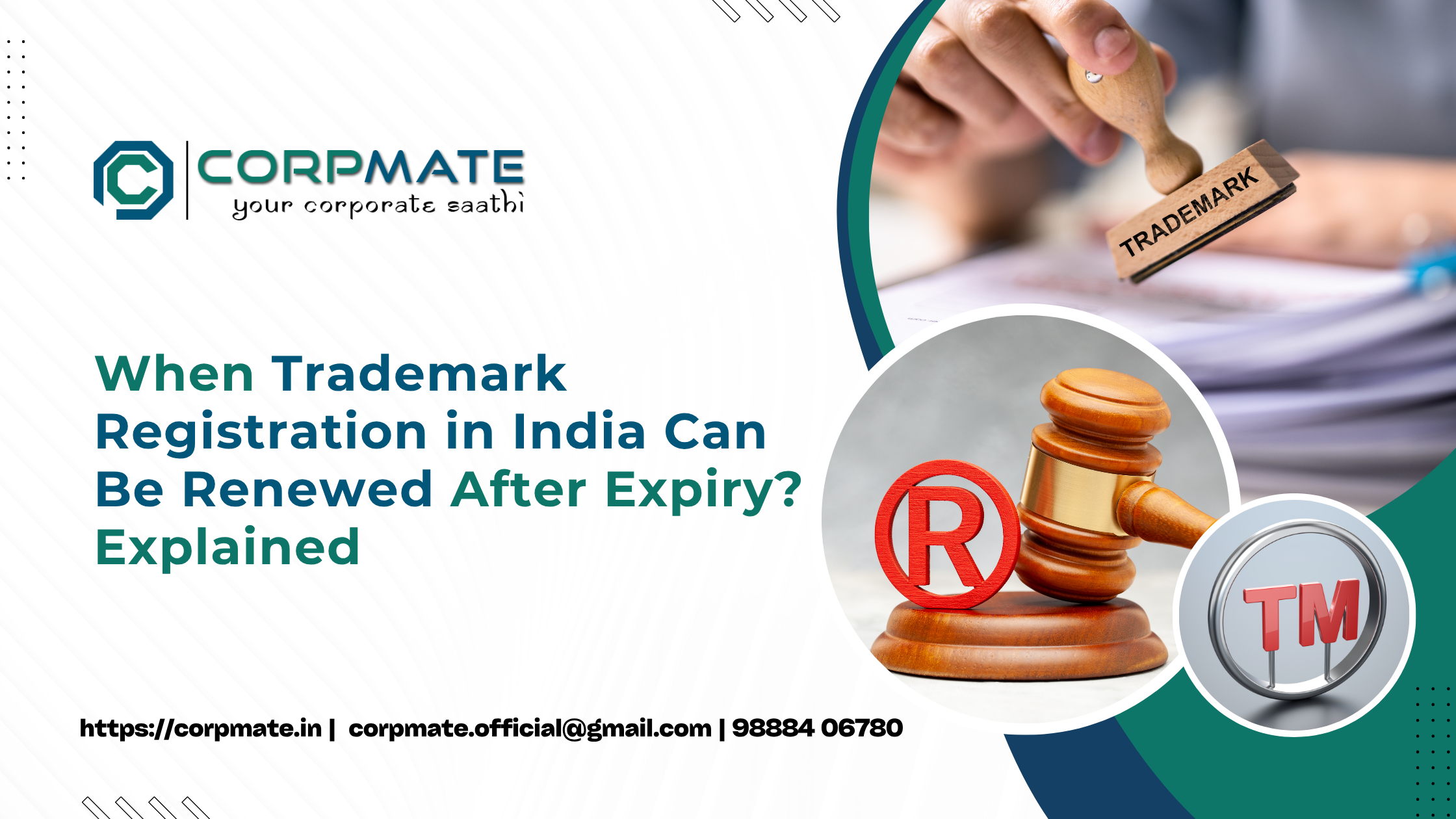Trademark registration offers exclusive rights to use a brand name, logo, slogan, or symbol, protecting a business’s identity and reputation. In India, a registered trademark is valid for 10 years and can be renewed indefinitely every 10 years. But what happens if a trademark expires? Can it still be renewed? This article explains when trademark registration in India can be renewed after expiry, the renewal process, applicable timeframes, penalties, and best practices to avoid cancellation.
Validity of Trademark Registration in India
A registered trademark in India is valid for 10 years from the date of application, not from the date of registration. To continue enjoying the protection and legal rights, the trademark owner must renew the trademark before expiry or within the grace period allowed by law.
- Governing Law: The Trade Marks Act, 1999
- Validity Period: 10 years
- Renewable: Indefinitely, every 10 years
When Can Trademark Registration Be Renewed After Expiry?
If a trademark owner fails to renew before the expiration date, the Trade Marks Act provides a grace period of 6 months after expiry to renew the trademark with an additional late fee.
✅ Key Renewal Timelines:
| Event | Timeframe |
| Trademark Registration Validity | 10 years from the date of application |
| Renewal Due | On or before expiry of the 10-year period |
| Grace Period for Renewal | Within 6 months after expiry |
| Restoration After Removal | Within 1 year from expiry (with justification) |
If the trademark is not renewed within 6 months, the Registrar of Trademarks removes it from the Register. However, it can still be restored within 1 year of expiry through a restoration application.
Trademark Renewal vs. Restoration
| Aspect | Renewal | Restoration |
| When Applicable | Within 6 months after expiry | After 6 months but within 1 year of expiry |
| Late Fees | Applicable | Higher fees + Statement of Reason for Delay |
| Risk Involved | Lower – Trademark is still on record | Higher – Trademark already removed from register |
| Legal Requirement | No justification required | Reasonable cause must be shown for failure to renew on time |
How to Renew a Trademark in India
The renewal process is straightforward and can be completed online through the official portal of the Controller General of Patents, Designs and Trade Marks.
Step-by-Step Trademark Renewal Process
- Check Renewal Due Date
- Calculate 10 years from the original application date.
- Set renewal reminders at least 6 months before expiry.
- Calculate 10 years from the original application date.
- File Renewal Application
- Form: TM-R
- Filing Options:
- Renew without modification
- Renew with modification in trademark or registered user details
- Renew without modification
- Form: TM-R
- Pay the Applicable Fees
- Standard Renewal Fee:
- ₹9,000 (e-filing)
- ₹10,000 (physical filing)
- ₹9,000 (e-filing)
- Late Fee (if within grace period): ₹450 per month
- Standard Renewal Fee:
- Acknowledgement and Publication
- The Registrar issues a renewal confirmation and publishes it in the Trademark Journal.
- The Registrar issues a renewal confirmation and publishes it in the Trademark Journal.
How to Restore a Trademark After Removal
If the renewal is not done within the 6-month grace period, the trademark will be removed from the register. In such cases, the owner may file for restoration.
Restoration Process
- File Application for Restoration
- Form: TM-R (same as renewal)
- Time Limit: Within 1 year of expiry
- Must include a statement of reason for failure to renew on time
- Form: TM-R (same as renewal)
- Payment of Restoration Fee
- ₹9,000 renewal fee + ₹9,000 restoration fee (e-filing)
- ₹9,000 renewal fee + ₹9,000 restoration fee (e-filing)
- Registrar’s Review
- The Registrar evaluates the justification and may allow or reject the restoration.
- The Registrar evaluates the justification and may allow or reject the restoration.
- Trademark Journal Publication
- If accepted, the trademark is published in the journal and restored on the register.
- If accepted, the trademark is published in the journal and restored on the register.
Documents Required for Renewal or Restoration
- Copy of registration certificate
- Power of Attorney (if filed through agent or attorney)
- Proof of usage (if required)
- TM-R form duly signed
- Statement of case (only for restoration)
Consequences of Not Renewing a Trademark
If a trademark is not renewed within the allowed timeframe, the rights to the mark are lost:
- Trademark becomes open for registration by others
- Legal protection ends
- Business may lose brand identity and goodwill
- Legal disputes may arise if someone else registers a similar mark
Tips to Ensure Timely Trademark Renewal
- Maintain a digital trademark portfolio with renewal dates
- Set automated reminders well in advance
- Work with legal professionals to track and file renewals on time
- Avoid waiting until the last month to apply for renewal
Recent Updates in Trademark Renewal Practice
As of 2024-25, the following procedural and system changes are in place:
- Mandatory e-filing for faster processing and acknowledgment
- Online tracking system available on ipindia.gov.in
- Real-time status updates through SMS/email notifications
- New integration with DPIIT’s startup recognition to fast-track certain trademark applications
Conclusion
Trademark renewal is essential to maintain exclusive rights and protect the brand legally. While the initial registration is valid for 10 years, it can be renewed indefinitely. If missed, the owner gets a 6-month grace period for renewal with late fees and 1 year for restoration with justification. Failing to act within this time results in the permanent loss of the trademark.To avoid the risk of cancellation, businesses should maintain an internal tracking mechanism and renew trademarks on time. At Corpmate, we assist clients with trademark registration, timely renewals, restoration, and complete IP portfolio management.

